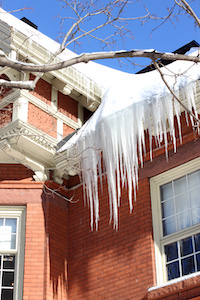 Winter is upon us and so is the likelihood of winter weather. Winter months can lead to a higher homeowners loss potential as snow and ice falls and without warning, can create damages to your home. Most damages caused by severe weather conditions are immediately detectible while others are not. One type of loss that may not be detectable until days later are ice dams. If you are not familiar with this type of claim, you need to read on to increase awareness of ice dams and the damages they can cause.
Winter is upon us and so is the likelihood of winter weather. Winter months can lead to a higher homeowners loss potential as snow and ice falls and without warning, can create damages to your home. Most damages caused by severe weather conditions are immediately detectible while others are not. One type of loss that may not be detectable until days later are ice dams. If you are not familiar with this type of claim, you need to read on to increase awareness of ice dams and the damages they can cause.
What is an Ice Dam?
An ice dam is caused when there is snow on your roof that begins to melt as the heat in your home rises. As the snow begins to melt and drain off the roof, part of it may re-freeze as it runs down from the peak to the lowest portion of your roof creating a ridge of ice acting as a dam. Water backing up behind the ice dam can seep into cracks and openings (and under shingles) and enter the attic which then can create water seepage in your exterior walls, insulation and into your home. Keep in mind that water and moisture entering your home can lead to mildew and mold causing costly damages and extensive repairs.
When snow/ice falls and accumulates on your roof, the weight of that precipitation can put a significant amount of stress on your home and threaten your roof. From weakening the support of your roof, to ice accumulating in your gutters, along with water back up under the shingles, your roof is put under undue stress.
Minimize the Risks of Ice Dams
The good news is that you can minimize the risks to your home and roof by following some key guidelines following heavy snow/ice creating the potential for ice dams.
Insulate- Make sure your attic is well insulated. Also, it is important to install ice shields around your vents, under your shingles, and along the edge of your roof. This will help to keep the melting water flow constant and away from icing up and creating an ice dam.
Keep Your Attic Cool- Keeping the attic and roof of your home cool will help minimize the chances of melting snow/ice and thus you won’t be faced with large amount of water that could re-freeze.
Ventilate- Having your attic well ventilated helps to ensure an even roof temperature which can help prevent ice dams after a huge snow fall. Your objective is to prevent heat from getting into your attic and roof.
Regardless of precautionary measures taken, ice dams can still form on your roof. If this does happen, it is recommended you contact a licensed professional to remove it as quickly as possible to prevent further damages along with immediately contacting your local N.Y. independent insurance agent to report the claim. Trying to remove it yourself can pose additional risks to you and your roof.
If you have any further questions or concerns regarding ice dams and the potential for damages, contact our offices at Cameron Insurance Group at 845-627-2130 and we will assist you in every way. We are here for all your homeowners insurance needs.





